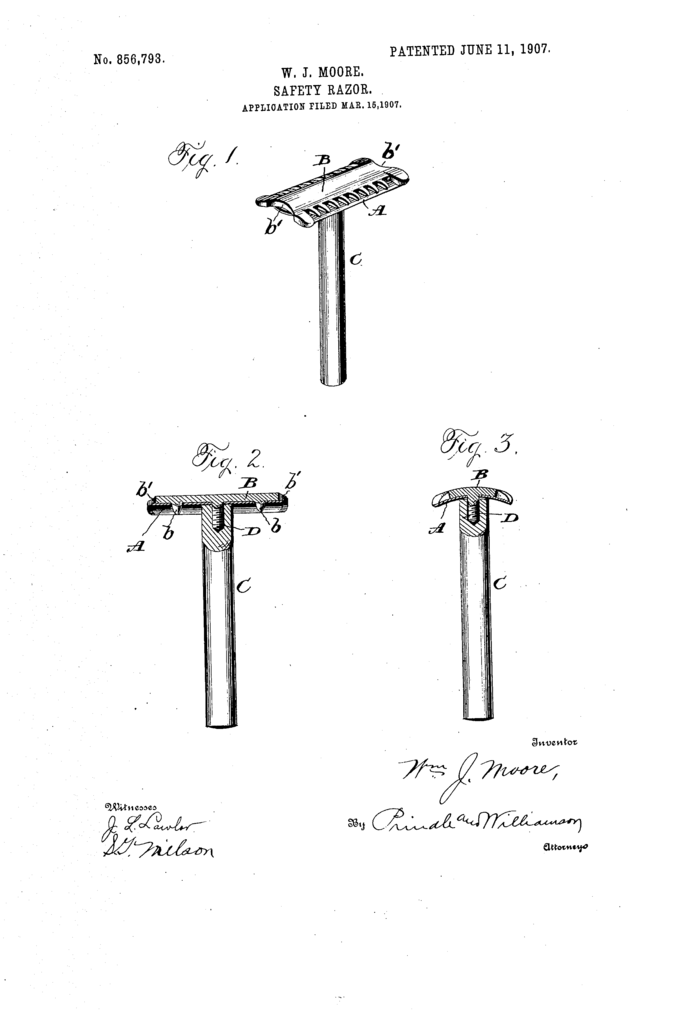Remember how difficult it was to disassemble and assemble your three piece safety razor the first time? Me neither, but William J Moore patented the solution in 1907; a Gillette razor – as described in US patent 775,134 – with the bottom plate removed.
Yes, you read that right. In order to make an admittedly simple safety razor simpler, Mr Moore did away with 25% of the parts. Instead of top cap, blade, baseplate and handle, William J Moore’s simplified safety razor contained top cap, blade and handle. To quote:
It will be evident that by giving the guard plate the location shown with reference to the blade, that is, on the side thereof that comes next the face, and which is opposite to the side to which the handle is applied, and from which it projects at a right-angle, make the guard plate perform the extra function of a supporting plate, and thereby materially simplify the structure, since one less part is necessary than in the case of the constructions heretofore employed in razors of this type, which simplification results in the double advantage of cheapening the cost of manufacture and simplifying the work of separation and assemblage of the parts.
US patent 856,793

In addition, Mr Moore claimed that his improved razor was easier to use than Gillette’s razor. Reading the patent text, I can see what he was going for… but given the plethora of William J Moore’s simplified safety razor that can easily be found in antiques shops, flea markets and so on, I would say the market didn’t agree with him.
An advantage, other than the simplification of the structure, which is derived by the location of the guard on the side of the blade which brings the guard next to the face, is that the degree of closeness of the shave can be determined or regulated in so simple a manner as the variation of the angle at which the razor is presented to the surface being shaved, a variation in the angle resulting in a change of distance of the razor edge from the surface being shaved. With the ordinary construction, wherein the guard is on the opposite side of the blade, the protrusion of the guard fingers beyond the edge of the razor is indispensable, and this precludes the possibility of regulating the closeness of the shave by change in the angle of presentation of the razor to the surface of the face, making it necessary when the degree of closeness of the shave is to be regulated to change or shift the position of the blade with reference to the guard, a procedure which is not only inconvenient and requires time, but which requires a certain degree of skill, which the inexperienced users of safety razors lack. By my invention, as a result of placing the guard on the side of the razor which comes next to the face, the razor edge projects beyond the edges of the guard fingers, as will be clearly seen by reference to the drawings, and it is because of this relative arrangement of the parts that it is possible with my razor to regvvvvvvvvvvvvvvvvvvvvvvvvvvvvvvvvvvvvvvvvvvvvvvvvulate the closeness of the shave by the angle of presentation of the razor to the surface of the face being shaved. It will be evident that, for the attainment of this important advantage in the use of my razor, it is necessary merely to have the handle in such position that it will not interfere with the application of the razor to the face, with the guard next the surface being shaved.
US patent 856,739
William J Moore have a few other patents to his name, including a couple of single edge safety razors – one set up for a wedge blade, the other for a spined blade similar to the Gem blades. The full text of the patent for his simplified safety razor can be read at Google Patents, as well as over at Razors.click.
